Kensington College: Principles of Financial Management Report
VerifiedAdded on 2023/01/10
|24
|5435
|27
Report
AI Summary
This report on financial management, prepared for a Higher National Diploma in Business, delves into core principles through the lens of British American Tobacco. It explores various approaches and techniques for effective decision-making, including knowledge-based and formal/informal approaches, along with the impact of socio-economic and financial factors. The report also examines stakeholder management, addressing conflicting objectives among different stakeholder groups. Furthermore, it emphasizes the value of management accounting in cost control, detailing techniques like variance analysis and activity-based costing. The report concludes with a discussion on fraud detection and prevention methods, including ethical decision-making approaches and a reflection on the learning experiences from the assignment.

Principles of financial management
Paraphrase This Document
Need a fresh take? Get an instant paraphrase of this document with our AI Paraphraser
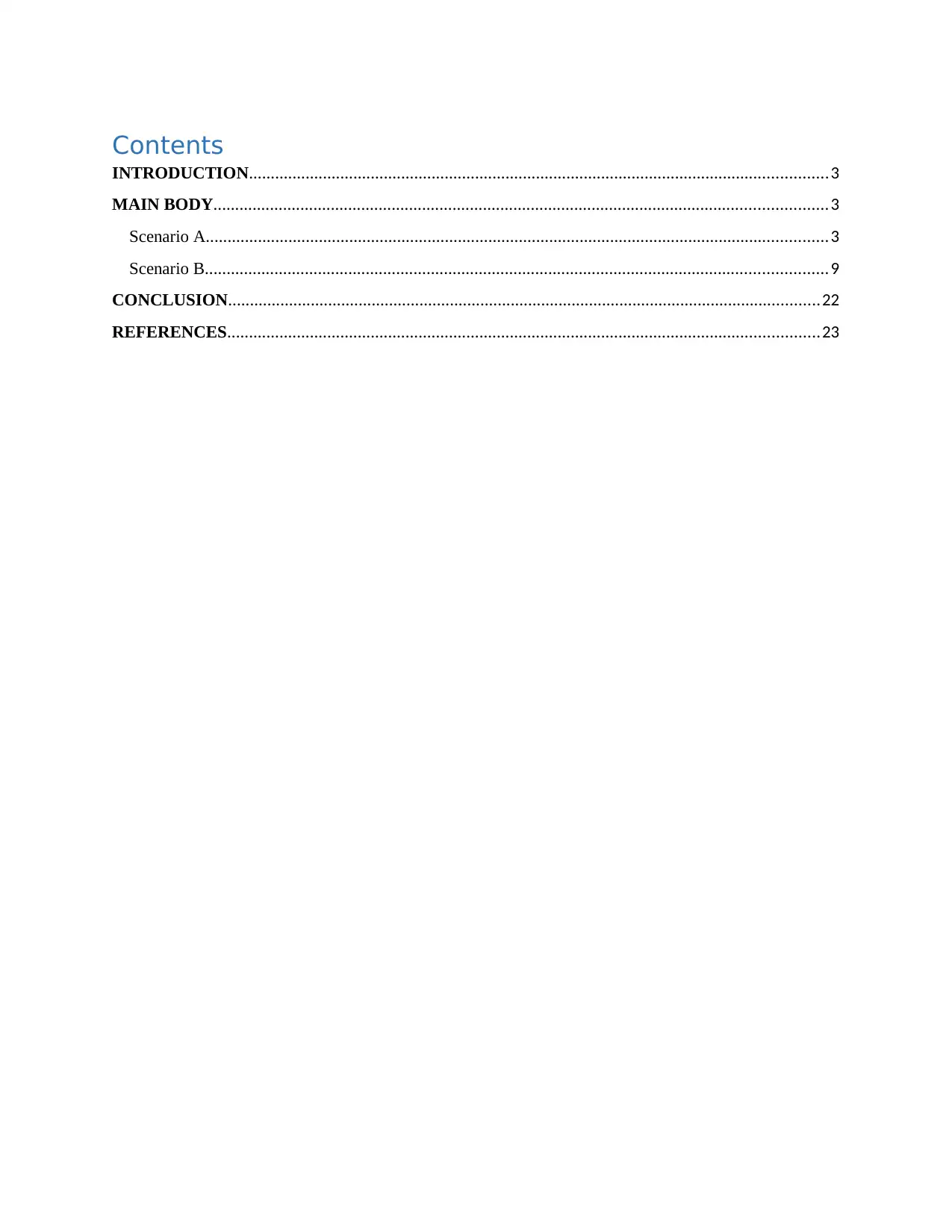
Contents
INTRODUCTION.....................................................................................................................................3
MAIN BODY.............................................................................................................................................3
Scenario A...............................................................................................................................................3
Scenario B...............................................................................................................................................9
CONCLUSION........................................................................................................................................22
REFERENCES........................................................................................................................................23
INTRODUCTION.....................................................................................................................................3
MAIN BODY.............................................................................................................................................3
Scenario A...............................................................................................................................................3
Scenario B...............................................................................................................................................9
CONCLUSION........................................................................................................................................22
REFERENCES........................................................................................................................................23
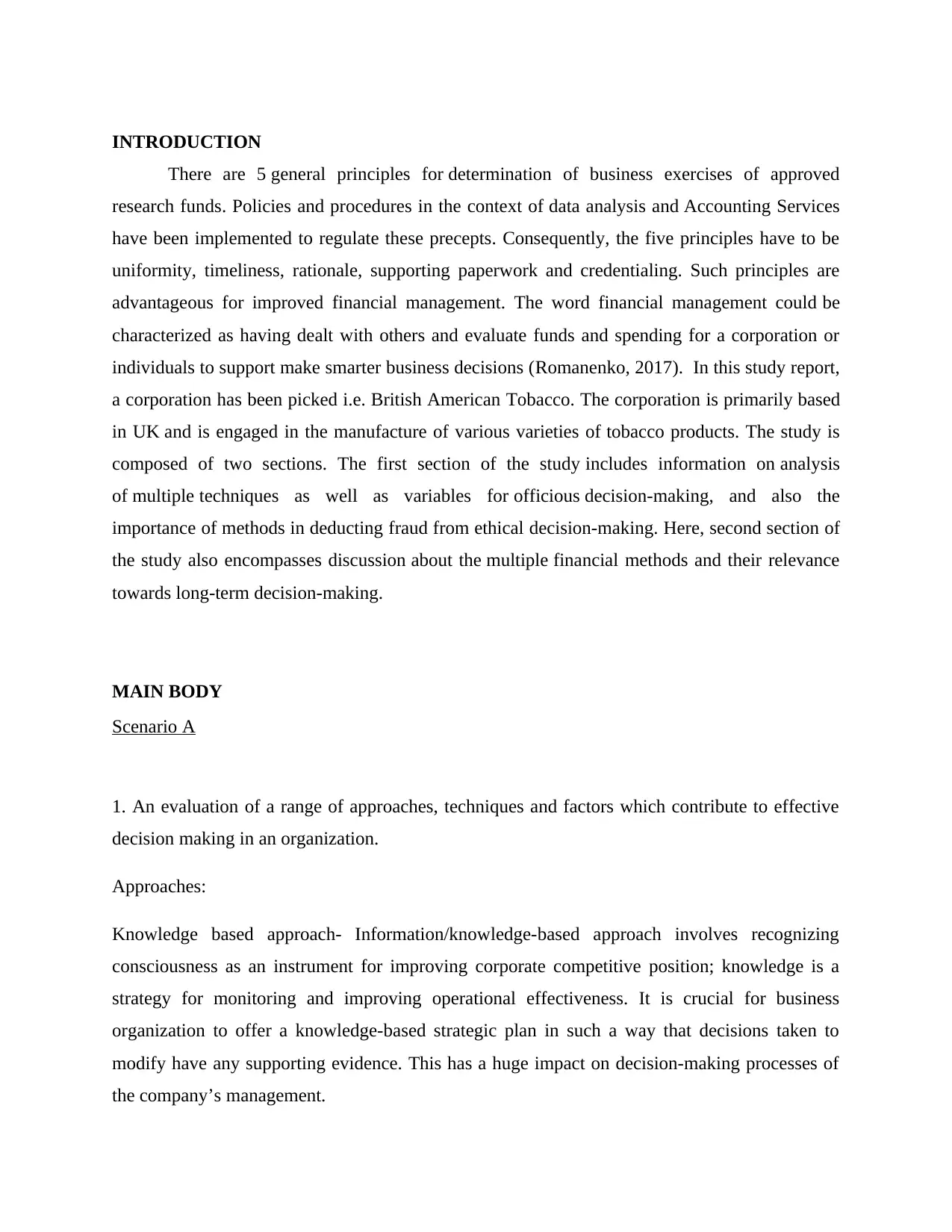
INTRODUCTION
There are 5 general principles for determination of business exercises of approved
research funds. Policies and procedures in the context of data analysis and Accounting Services
have been implemented to regulate these precepts. Consequently, the five principles have to be
uniformity, timeliness, rationale, supporting paperwork and credentialing. Such principles are
advantageous for improved financial management. The word financial management could be
characterized as having dealt with others and evaluate funds and spending for a corporation or
individuals to support make smarter business decisions (Romanenko, 2017). In this study report,
a corporation has been picked i.e. British American Tobacco. The corporation is primarily based
in UK and is engaged in the manufacture of various varieties of tobacco products. The study is
composed of two sections. The first section of the study includes information on analysis
of multiple techniques as well as variables for officious decision-making, and also the
importance of methods in deducting fraud from ethical decision-making. Here, second section of
the study also encompasses discussion about the multiple financial methods and their relevance
towards long-term decision-making.
MAIN BODY
Scenario A
1. An evaluation of a range of approaches, techniques and factors which contribute to effective
decision making in an organization.
Approaches:
Knowledge based approach- Information/knowledge-based approach involves recognizing
consciousness as an instrument for improving corporate competitive position; knowledge is a
strategy for monitoring and improving operational effectiveness. It is crucial for business
organization to offer a knowledge-based strategic plan in such a way that decisions taken to
modify have any supporting evidence. This has a huge impact on decision-making processes of
the company’s management.
There are 5 general principles for determination of business exercises of approved
research funds. Policies and procedures in the context of data analysis and Accounting Services
have been implemented to regulate these precepts. Consequently, the five principles have to be
uniformity, timeliness, rationale, supporting paperwork and credentialing. Such principles are
advantageous for improved financial management. The word financial management could be
characterized as having dealt with others and evaluate funds and spending for a corporation or
individuals to support make smarter business decisions (Romanenko, 2017). In this study report,
a corporation has been picked i.e. British American Tobacco. The corporation is primarily based
in UK and is engaged in the manufacture of various varieties of tobacco products. The study is
composed of two sections. The first section of the study includes information on analysis
of multiple techniques as well as variables for officious decision-making, and also the
importance of methods in deducting fraud from ethical decision-making. Here, second section of
the study also encompasses discussion about the multiple financial methods and their relevance
towards long-term decision-making.
MAIN BODY
Scenario A
1. An evaluation of a range of approaches, techniques and factors which contribute to effective
decision making in an organization.
Approaches:
Knowledge based approach- Information/knowledge-based approach involves recognizing
consciousness as an instrument for improving corporate competitive position; knowledge is a
strategy for monitoring and improving operational effectiveness. It is crucial for business
organization to offer a knowledge-based strategic plan in such a way that decisions taken to
modify have any supporting evidence. This has a huge impact on decision-making processes of
the company’s management.
⊘ This is a preview!⊘
Do you want full access?
Subscribe today to unlock all pages.

Trusted by 1+ million students worldwide
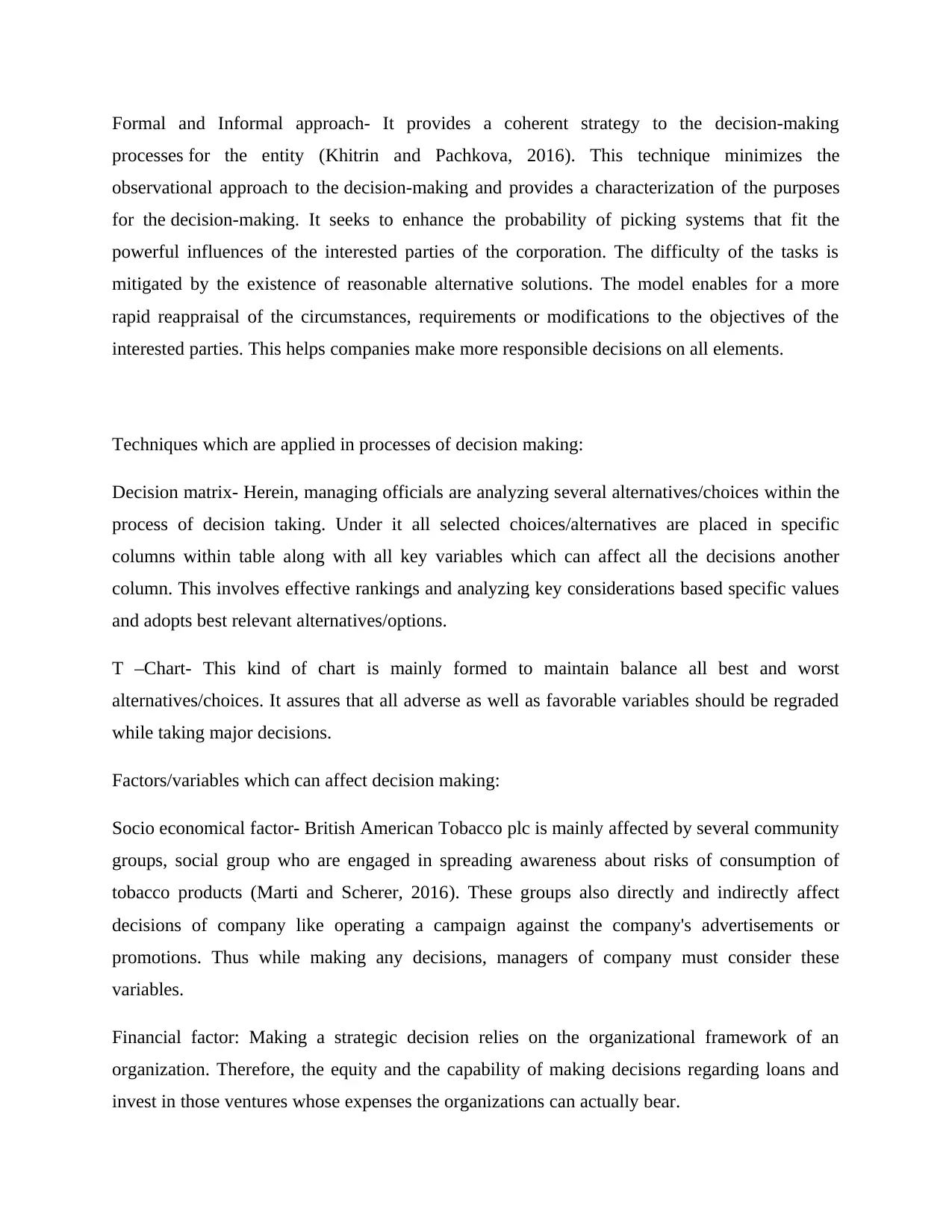
Formal and Informal approach- It provides a coherent strategy to the decision-making
processes for the entity (Khitrin and Pachkova, 2016). This technique minimizes the
observational approach to the decision-making and provides a characterization of the purposes
for the decision-making. It seeks to enhance the probability of picking systems that fit the
powerful influences of the interested parties of the corporation. The difficulty of the tasks is
mitigated by the existence of reasonable alternative solutions. The model enables for a more
rapid reappraisal of the circumstances, requirements or modifications to the objectives of the
interested parties. This helps companies make more responsible decisions on all elements.
Techniques which are applied in processes of decision making:
Decision matrix- Herein, managing officials are analyzing several alternatives/choices within the
process of decision taking. Under it all selected choices/alternatives are placed in specific
columns within table along with all key variables which can affect all the decisions another
column. This involves effective rankings and analyzing key considerations based specific values
and adopts best relevant alternatives/options.
T –Chart- This kind of chart is mainly formed to maintain balance all best and worst
alternatives/choices. It assures that all adverse as well as favorable variables should be regraded
while taking major decisions.
Factors/variables which can affect decision making:
Socio economical factor- British American Tobacco plc is mainly affected by several community
groups, social group who are engaged in spreading awareness about risks of consumption of
tobacco products (Marti and Scherer, 2016). These groups also directly and indirectly affect
decisions of company like operating a campaign against the company's advertisements or
promotions. Thus while making any decisions, managers of company must consider these
variables.
Financial factor: Making a strategic decision relies on the organizational framework of an
organization. Therefore, the equity and the capability of making decisions regarding loans and
invest in those ventures whose expenses the organizations can actually bear.
processes for the entity (Khitrin and Pachkova, 2016). This technique minimizes the
observational approach to the decision-making and provides a characterization of the purposes
for the decision-making. It seeks to enhance the probability of picking systems that fit the
powerful influences of the interested parties of the corporation. The difficulty of the tasks is
mitigated by the existence of reasonable alternative solutions. The model enables for a more
rapid reappraisal of the circumstances, requirements or modifications to the objectives of the
interested parties. This helps companies make more responsible decisions on all elements.
Techniques which are applied in processes of decision making:
Decision matrix- Herein, managing officials are analyzing several alternatives/choices within the
process of decision taking. Under it all selected choices/alternatives are placed in specific
columns within table along with all key variables which can affect all the decisions another
column. This involves effective rankings and analyzing key considerations based specific values
and adopts best relevant alternatives/options.
T –Chart- This kind of chart is mainly formed to maintain balance all best and worst
alternatives/choices. It assures that all adverse as well as favorable variables should be regraded
while taking major decisions.
Factors/variables which can affect decision making:
Socio economical factor- British American Tobacco plc is mainly affected by several community
groups, social group who are engaged in spreading awareness about risks of consumption of
tobacco products (Marti and Scherer, 2016). These groups also directly and indirectly affect
decisions of company like operating a campaign against the company's advertisements or
promotions. Thus while making any decisions, managers of company must consider these
variables.
Financial factor: Making a strategic decision relies on the organizational framework of an
organization. Therefore, the equity and the capability of making decisions regarding loans and
invest in those ventures whose expenses the organizations can actually bear.
Paraphrase This Document
Need a fresh take? Get an instant paraphrase of this document with our AI Paraphraser
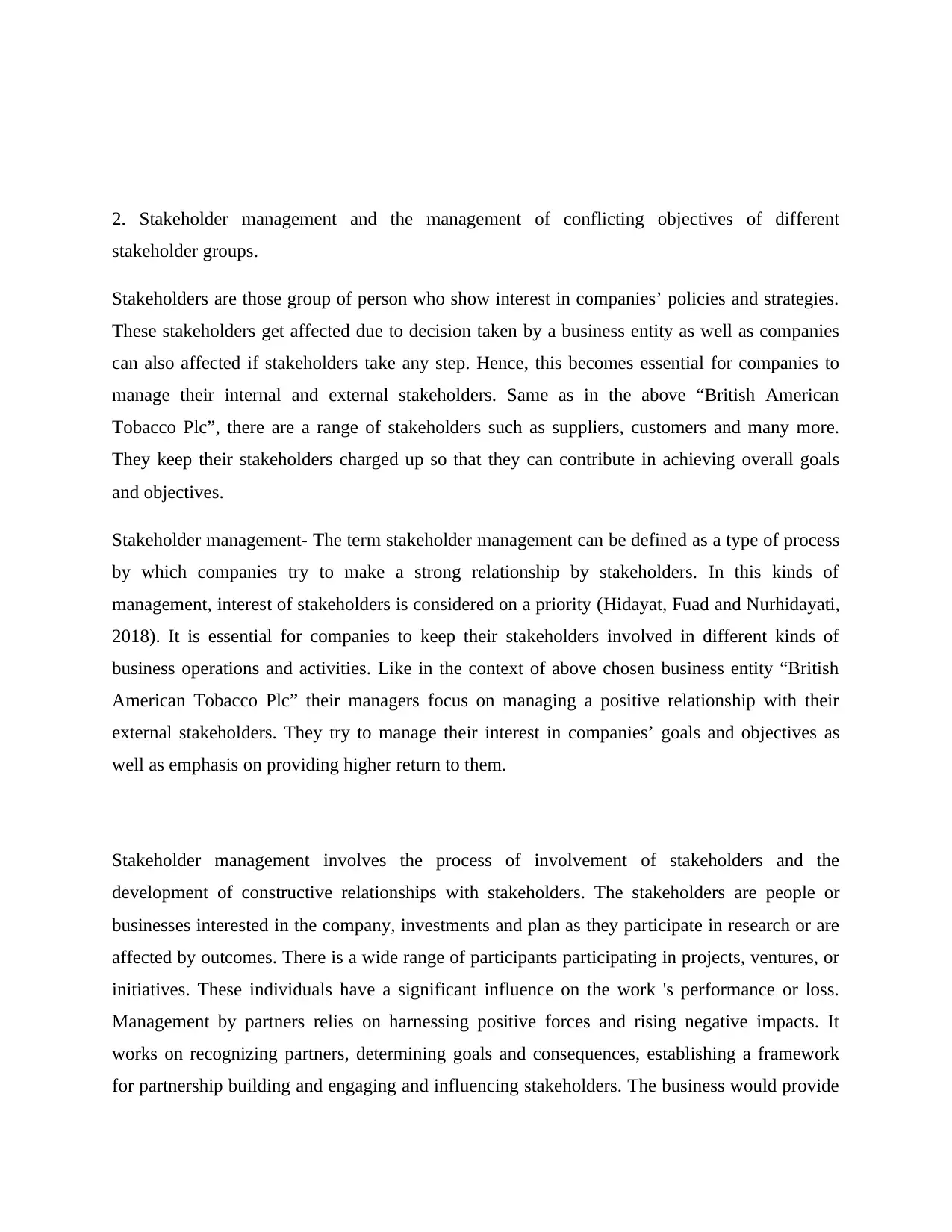
2. Stakeholder management and the management of conflicting objectives of different
stakeholder groups.
Stakeholders are those group of person who show interest in companies’ policies and strategies.
These stakeholders get affected due to decision taken by a business entity as well as companies
can also affected if stakeholders take any step. Hence, this becomes essential for companies to
manage their internal and external stakeholders. Same as in the above “British American
Tobacco Plc”, there are a range of stakeholders such as suppliers, customers and many more.
They keep their stakeholders charged up so that they can contribute in achieving overall goals
and objectives.
Stakeholder management- The term stakeholder management can be defined as a type of process
by which companies try to make a strong relationship by stakeholders. In this kinds of
management, interest of stakeholders is considered on a priority (Hidayat, Fuad and Nurhidayati,
2018). It is essential for companies to keep their stakeholders involved in different kinds of
business operations and activities. Like in the context of above chosen business entity “British
American Tobacco Plc” their managers focus on managing a positive relationship with their
external stakeholders. They try to manage their interest in companies’ goals and objectives as
well as emphasis on providing higher return to them.
Stakeholder management involves the process of involvement of stakeholders and the
development of constructive relationships with stakeholders. The stakeholders are people or
businesses interested in the company, investments and plan as they participate in research or are
affected by outcomes. There is a wide range of participants participating in projects, ventures, or
initiatives. These individuals have a significant influence on the work 's performance or loss.
Management by partners relies on harnessing positive forces and rising negative impacts. It
works on recognizing partners, determining goals and consequences, establishing a framework
for partnership building and engaging and influencing stakeholders. The business would provide
stakeholder groups.
Stakeholders are those group of person who show interest in companies’ policies and strategies.
These stakeholders get affected due to decision taken by a business entity as well as companies
can also affected if stakeholders take any step. Hence, this becomes essential for companies to
manage their internal and external stakeholders. Same as in the above “British American
Tobacco Plc”, there are a range of stakeholders such as suppliers, customers and many more.
They keep their stakeholders charged up so that they can contribute in achieving overall goals
and objectives.
Stakeholder management- The term stakeholder management can be defined as a type of process
by which companies try to make a strong relationship by stakeholders. In this kinds of
management, interest of stakeholders is considered on a priority (Hidayat, Fuad and Nurhidayati,
2018). It is essential for companies to keep their stakeholders involved in different kinds of
business operations and activities. Like in the context of above chosen business entity “British
American Tobacco Plc” their managers focus on managing a positive relationship with their
external stakeholders. They try to manage their interest in companies’ goals and objectives as
well as emphasis on providing higher return to them.
Stakeholder management involves the process of involvement of stakeholders and the
development of constructive relationships with stakeholders. The stakeholders are people or
businesses interested in the company, investments and plan as they participate in research or are
affected by outcomes. There is a wide range of participants participating in projects, ventures, or
initiatives. These individuals have a significant influence on the work 's performance or loss.
Management by partners relies on harnessing positive forces and rising negative impacts. It
works on recognizing partners, determining goals and consequences, establishing a framework
for partnership building and engaging and influencing stakeholders. The business would provide
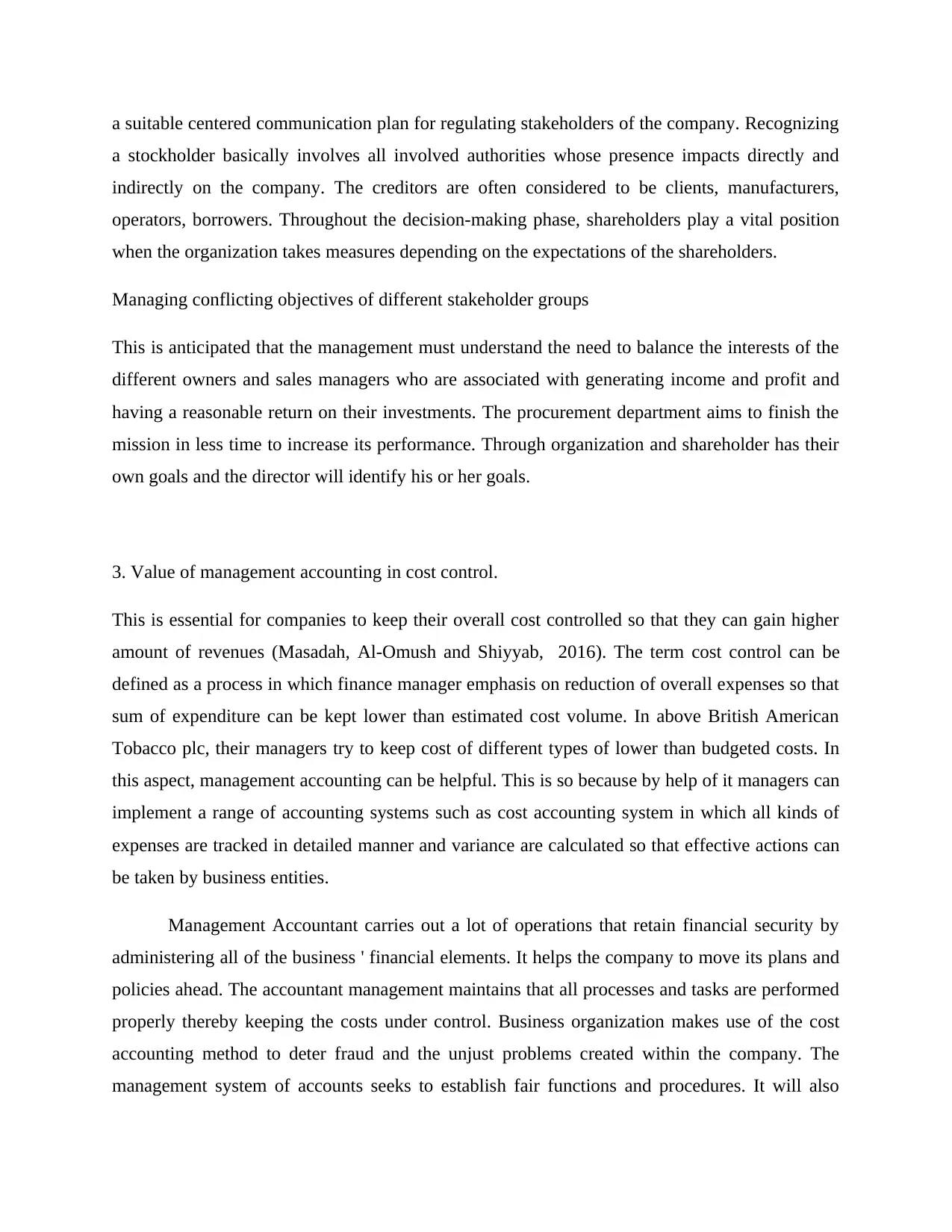
a suitable centered communication plan for regulating stakeholders of the company. Recognizing
a stockholder basically involves all involved authorities whose presence impacts directly and
indirectly on the company. The creditors are often considered to be clients, manufacturers,
operators, borrowers. Throughout the decision-making phase, shareholders play a vital position
when the organization takes measures depending on the expectations of the shareholders.
Managing conflicting objectives of different stakeholder groups
This is anticipated that the management must understand the need to balance the interests of the
different owners and sales managers who are associated with generating income and profit and
having a reasonable return on their investments. The procurement department aims to finish the
mission in less time to increase its performance. Through organization and shareholder has their
own goals and the director will identify his or her goals.
3. Value of management accounting in cost control.
This is essential for companies to keep their overall cost controlled so that they can gain higher
amount of revenues (Masadah, Al-Omush and Shiyyab, 2016). The term cost control can be
defined as a process in which finance manager emphasis on reduction of overall expenses so that
sum of expenditure can be kept lower than estimated cost volume. In above British American
Tobacco plc, their managers try to keep cost of different types of lower than budgeted costs. In
this aspect, management accounting can be helpful. This is so because by help of it managers can
implement a range of accounting systems such as cost accounting system in which all kinds of
expenses are tracked in detailed manner and variance are calculated so that effective actions can
be taken by business entities.
Management Accountant carries out a lot of operations that retain financial security by
administering all of the business ' financial elements. It helps the company to move its plans and
policies ahead. The accountant management maintains that all processes and tasks are performed
properly thereby keeping the costs under control. Business organization makes use of the cost
accounting method to deter fraud and the unjust problems created within the company. The
management system of accounts seeks to establish fair functions and procedures. It will also
a stockholder basically involves all involved authorities whose presence impacts directly and
indirectly on the company. The creditors are often considered to be clients, manufacturers,
operators, borrowers. Throughout the decision-making phase, shareholders play a vital position
when the organization takes measures depending on the expectations of the shareholders.
Managing conflicting objectives of different stakeholder groups
This is anticipated that the management must understand the need to balance the interests of the
different owners and sales managers who are associated with generating income and profit and
having a reasonable return on their investments. The procurement department aims to finish the
mission in less time to increase its performance. Through organization and shareholder has their
own goals and the director will identify his or her goals.
3. Value of management accounting in cost control.
This is essential for companies to keep their overall cost controlled so that they can gain higher
amount of revenues (Masadah, Al-Omush and Shiyyab, 2016). The term cost control can be
defined as a process in which finance manager emphasis on reduction of overall expenses so that
sum of expenditure can be kept lower than estimated cost volume. In above British American
Tobacco plc, their managers try to keep cost of different types of lower than budgeted costs. In
this aspect, management accounting can be helpful. This is so because by help of it managers can
implement a range of accounting systems such as cost accounting system in which all kinds of
expenses are tracked in detailed manner and variance are calculated so that effective actions can
be taken by business entities.
Management Accountant carries out a lot of operations that retain financial security by
administering all of the business ' financial elements. It helps the company to move its plans and
policies ahead. The accountant management maintains that all processes and tasks are performed
properly thereby keeping the costs under control. Business organization makes use of the cost
accounting method to deter fraud and the unjust problems created within the company. The
management system of accounts seeks to establish fair functions and procedures. It will also
⊘ This is a preview!⊘
Do you want full access?
Subscribe today to unlock all pages.

Trusted by 1+ million students worldwide
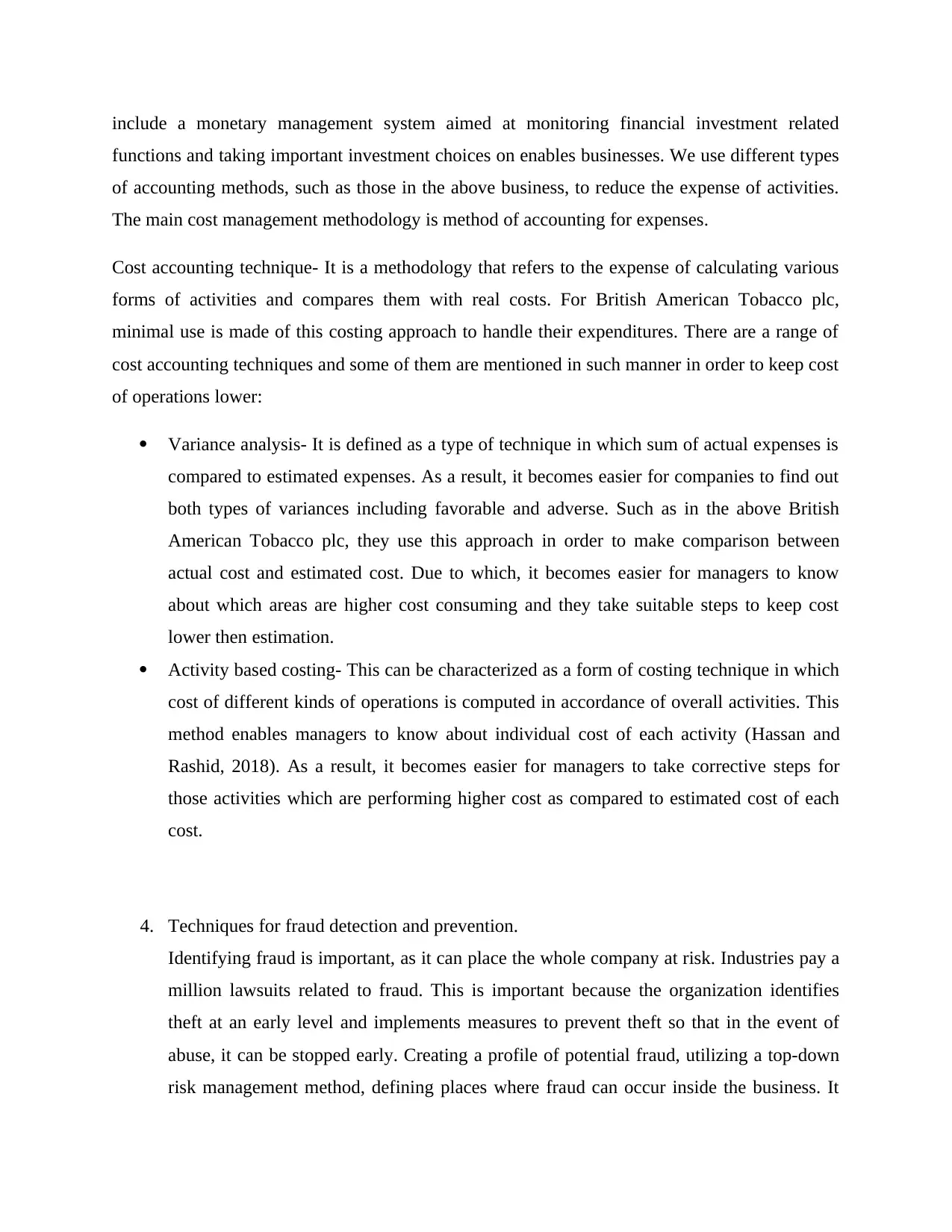
include a monetary management system aimed at monitoring financial investment related
functions and taking important investment choices on enables businesses. We use different types
of accounting methods, such as those in the above business, to reduce the expense of activities.
The main cost management methodology is method of accounting for expenses.
Cost accounting technique- It is a methodology that refers to the expense of calculating various
forms of activities and compares them with real costs. For British American Tobacco plc,
minimal use is made of this costing approach to handle their expenditures. There are a range of
cost accounting techniques and some of them are mentioned in such manner in order to keep cost
of operations lower:
Variance analysis- It is defined as a type of technique in which sum of actual expenses is
compared to estimated expenses. As a result, it becomes easier for companies to find out
both types of variances including favorable and adverse. Such as in the above British
American Tobacco plc, they use this approach in order to make comparison between
actual cost and estimated cost. Due to which, it becomes easier for managers to know
about which areas are higher cost consuming and they take suitable steps to keep cost
lower then estimation.
Activity based costing- This can be characterized as a form of costing technique in which
cost of different kinds of operations is computed in accordance of overall activities. This
method enables managers to know about individual cost of each activity (Hassan and
Rashid, 2018). As a result, it becomes easier for managers to take corrective steps for
those activities which are performing higher cost as compared to estimated cost of each
cost.
4. Techniques for fraud detection and prevention.
Identifying fraud is important, as it can place the whole company at risk. Industries pay a
million lawsuits related to fraud. This is important because the organization identifies
theft at an early level and implements measures to prevent theft so that in the event of
abuse, it can be stopped early. Creating a profile of potential fraud, utilizing a top-down
risk management method, defining places where fraud can occur inside the business. It
functions and taking important investment choices on enables businesses. We use different types
of accounting methods, such as those in the above business, to reduce the expense of activities.
The main cost management methodology is method of accounting for expenses.
Cost accounting technique- It is a methodology that refers to the expense of calculating various
forms of activities and compares them with real costs. For British American Tobacco plc,
minimal use is made of this costing approach to handle their expenditures. There are a range of
cost accounting techniques and some of them are mentioned in such manner in order to keep cost
of operations lower:
Variance analysis- It is defined as a type of technique in which sum of actual expenses is
compared to estimated expenses. As a result, it becomes easier for companies to find out
both types of variances including favorable and adverse. Such as in the above British
American Tobacco plc, they use this approach in order to make comparison between
actual cost and estimated cost. Due to which, it becomes easier for managers to know
about which areas are higher cost consuming and they take suitable steps to keep cost
lower then estimation.
Activity based costing- This can be characterized as a form of costing technique in which
cost of different kinds of operations is computed in accordance of overall activities. This
method enables managers to know about individual cost of each activity (Hassan and
Rashid, 2018). As a result, it becomes easier for managers to take corrective steps for
those activities which are performing higher cost as compared to estimated cost of each
cost.
4. Techniques for fraud detection and prevention.
Identifying fraud is important, as it can place the whole company at risk. Industries pay a
million lawsuits related to fraud. This is important because the organization identifies
theft at an early level and implements measures to prevent theft so that in the event of
abuse, it can be stopped early. Creating a profile of potential fraud, utilizing a top-down
risk management method, defining places where fraud can occur inside the business. It
Paraphrase This Document
Need a fresh take? Get an instant paraphrase of this document with our AI Paraphraser
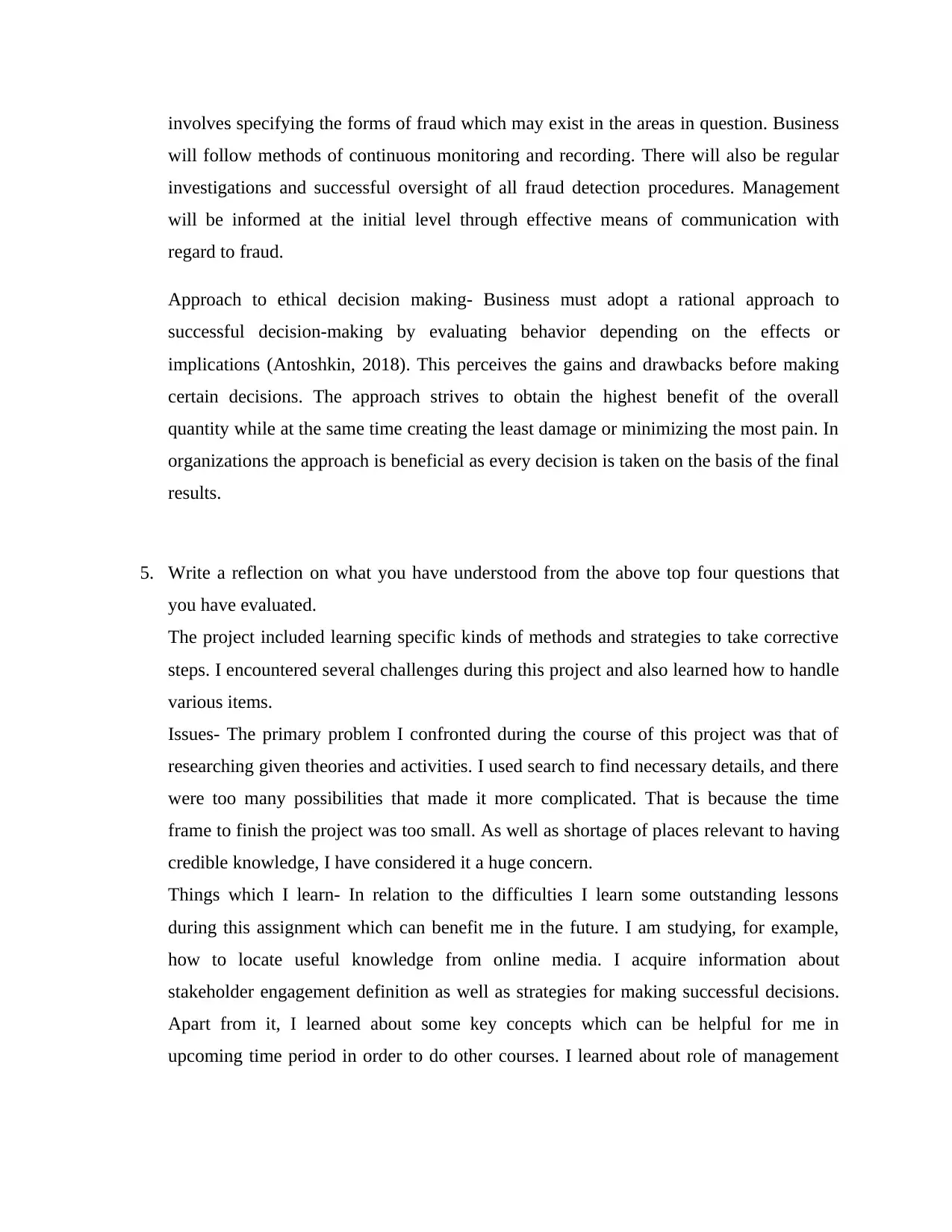
involves specifying the forms of fraud which may exist in the areas in question. Business
will follow methods of continuous monitoring and recording. There will also be regular
investigations and successful oversight of all fraud detection procedures. Management
will be informed at the initial level through effective means of communication with
regard to fraud.
Approach to ethical decision making- Business must adopt a rational approach to
successful decision-making by evaluating behavior depending on the effects or
implications (Antoshkin, 2018). This perceives the gains and drawbacks before making
certain decisions. The approach strives to obtain the highest benefit of the overall
quantity while at the same time creating the least damage or minimizing the most pain. In
organizations the approach is beneficial as every decision is taken on the basis of the final
results.
5. Write a reflection on what you have understood from the above top four questions that
you have evaluated.
The project included learning specific kinds of methods and strategies to take corrective
steps. I encountered several challenges during this project and also learned how to handle
various items.
Issues- The primary problem I confronted during the course of this project was that of
researching given theories and activities. I used search to find necessary details, and there
were too many possibilities that made it more complicated. That is because the time
frame to finish the project was too small. As well as shortage of places relevant to having
credible knowledge, I have considered it a huge concern.
Things which I learn- In relation to the difficulties I learn some outstanding lessons
during this assignment which can benefit me in the future. I am studying, for example,
how to locate useful knowledge from online media. I acquire information about
stakeholder engagement definition as well as strategies for making successful decisions.
Apart from it, I learned about some key concepts which can be helpful for me in
upcoming time period in order to do other courses. I learned about role of management
will follow methods of continuous monitoring and recording. There will also be regular
investigations and successful oversight of all fraud detection procedures. Management
will be informed at the initial level through effective means of communication with
regard to fraud.
Approach to ethical decision making- Business must adopt a rational approach to
successful decision-making by evaluating behavior depending on the effects or
implications (Antoshkin, 2018). This perceives the gains and drawbacks before making
certain decisions. The approach strives to obtain the highest benefit of the overall
quantity while at the same time creating the least damage or minimizing the most pain. In
organizations the approach is beneficial as every decision is taken on the basis of the final
results.
5. Write a reflection on what you have understood from the above top four questions that
you have evaluated.
The project included learning specific kinds of methods and strategies to take corrective
steps. I encountered several challenges during this project and also learned how to handle
various items.
Issues- The primary problem I confronted during the course of this project was that of
researching given theories and activities. I used search to find necessary details, and there
were too many possibilities that made it more complicated. That is because the time
frame to finish the project was too small. As well as shortage of places relevant to having
credible knowledge, I have considered it a huge concern.
Things which I learn- In relation to the difficulties I learn some outstanding lessons
during this assignment which can benefit me in the future. I am studying, for example,
how to locate useful knowledge from online media. I acquire information about
stakeholder engagement definition as well as strategies for making successful decisions.
Apart from it, I learned about some key concepts which can be helpful for me in
upcoming time period in order to do other courses. I learned about role of management
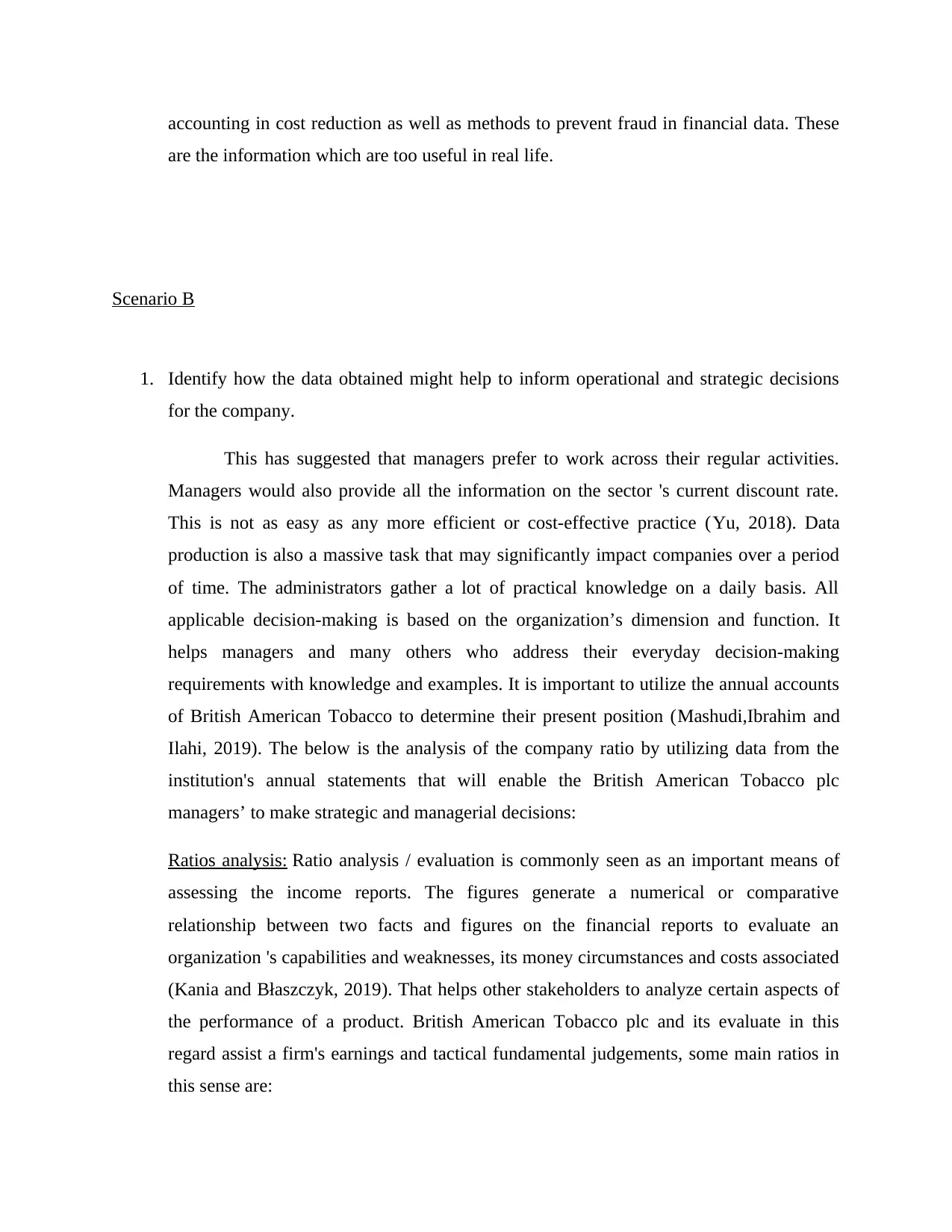
accounting in cost reduction as well as methods to prevent fraud in financial data. These
are the information which are too useful in real life.
Scenario B
1. Identify how the data obtained might help to inform operational and strategic decisions
for the company.
This has suggested that managers prefer to work across their regular activities.
Managers would also provide all the information on the sector 's current discount rate.
This is not as easy as any more efficient or cost-effective practice (Yu, 2018). Data
production is also a massive task that may significantly impact companies over a period
of time. The administrators gather a lot of practical knowledge on a daily basis. All
applicable decision-making is based on the organization’s dimension and function. It
helps managers and many others who address their everyday decision-making
requirements with knowledge and examples. It is important to utilize the annual accounts
of British American Tobacco to determine their present position (Mashudi,Ibrahim and
Ilahi, 2019). The below is the analysis of the company ratio by utilizing data from the
institution's annual statements that will enable the British American Tobacco plc
managers’ to make strategic and managerial decisions:
Ratios analysis: Ratio analysis / evaluation is commonly seen as an important means of
assessing the income reports. The figures generate a numerical or comparative
relationship between two facts and figures on the financial reports to evaluate an
organization 's capabilities and weaknesses, its money circumstances and costs associated
(Kania and Błaszczyk, 2019). That helps other stakeholders to analyze certain aspects of
the performance of a product. British American Tobacco plc and its evaluate in this
regard assist a firm's earnings and tactical fundamental judgements, some main ratios in
this sense are:
are the information which are too useful in real life.
Scenario B
1. Identify how the data obtained might help to inform operational and strategic decisions
for the company.
This has suggested that managers prefer to work across their regular activities.
Managers would also provide all the information on the sector 's current discount rate.
This is not as easy as any more efficient or cost-effective practice (Yu, 2018). Data
production is also a massive task that may significantly impact companies over a period
of time. The administrators gather a lot of practical knowledge on a daily basis. All
applicable decision-making is based on the organization’s dimension and function. It
helps managers and many others who address their everyday decision-making
requirements with knowledge and examples. It is important to utilize the annual accounts
of British American Tobacco to determine their present position (Mashudi,Ibrahim and
Ilahi, 2019). The below is the analysis of the company ratio by utilizing data from the
institution's annual statements that will enable the British American Tobacco plc
managers’ to make strategic and managerial decisions:
Ratios analysis: Ratio analysis / evaluation is commonly seen as an important means of
assessing the income reports. The figures generate a numerical or comparative
relationship between two facts and figures on the financial reports to evaluate an
organization 's capabilities and weaknesses, its money circumstances and costs associated
(Kania and Błaszczyk, 2019). That helps other stakeholders to analyze certain aspects of
the performance of a product. British American Tobacco plc and its evaluate in this
regard assist a firm's earnings and tactical fundamental judgements, some main ratios in
this sense are:
⊘ This is a preview!⊘
Do you want full access?
Subscribe today to unlock all pages.

Trusted by 1+ million students worldwide
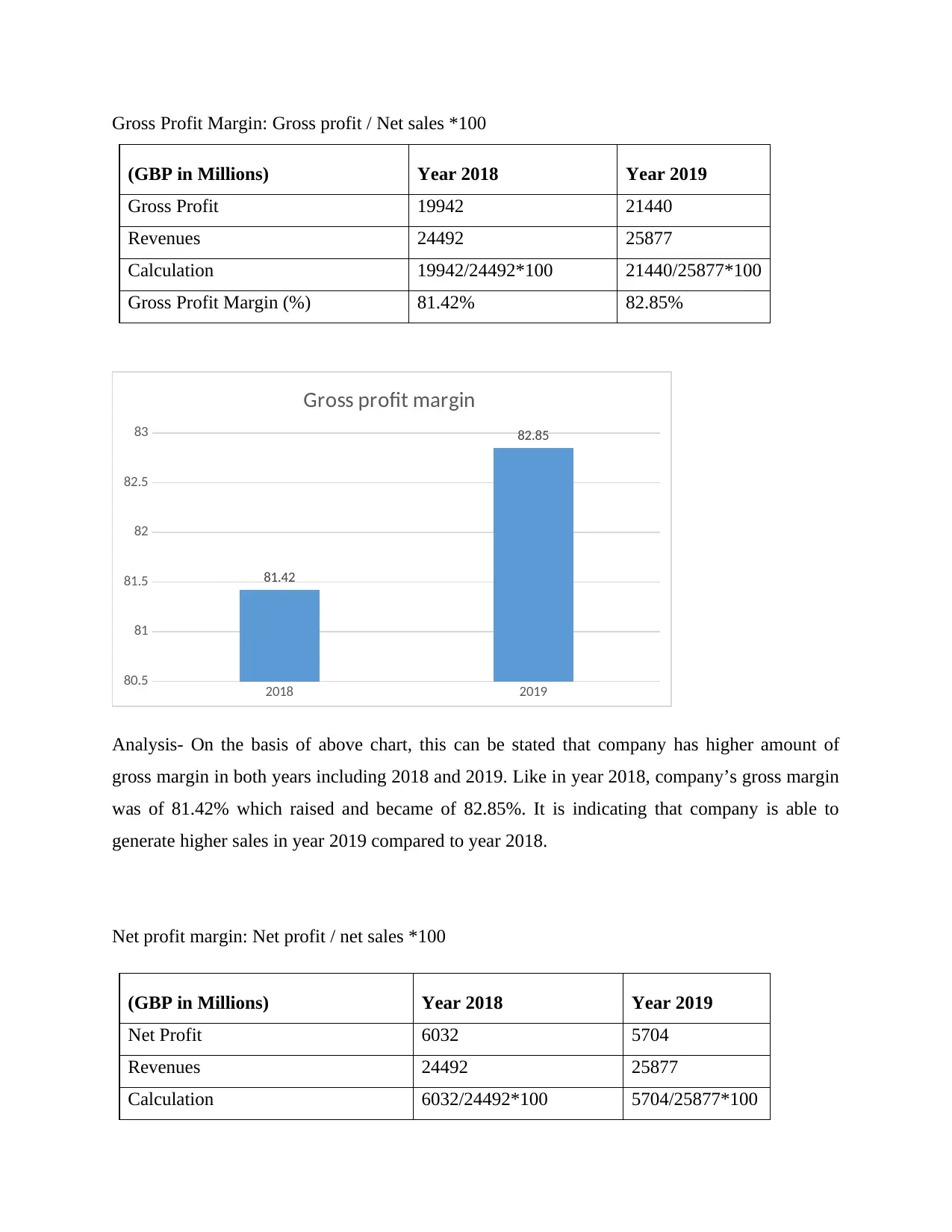
Gross Profit Margin: Gross profit / Net sales *100
(GBP in Millions) Year 2018 Year 2019
Gross Profit 19942 21440
Revenues 24492 25877
Calculation 19942/24492*100 21440/25877*100
Gross Profit Margin (%) 81.42% 82.85%
2018 2019
80.5
81
81.5
82
82.5
83
81.42
82.85
Gross profit margin
Analysis- On the basis of above chart, this can be stated that company has higher amount of
gross margin in both years including 2018 and 2019. Like in year 2018, company’s gross margin
was of 81.42% which raised and became of 82.85%. It is indicating that company is able to
generate higher sales in year 2019 compared to year 2018.
Net profit margin: Net profit / net sales *100
(GBP in Millions) Year 2018 Year 2019
Net Profit 6032 5704
Revenues 24492 25877
Calculation 6032/24492*100 5704/25877*100
(GBP in Millions) Year 2018 Year 2019
Gross Profit 19942 21440
Revenues 24492 25877
Calculation 19942/24492*100 21440/25877*100
Gross Profit Margin (%) 81.42% 82.85%
2018 2019
80.5
81
81.5
82
82.5
83
81.42
82.85
Gross profit margin
Analysis- On the basis of above chart, this can be stated that company has higher amount of
gross margin in both years including 2018 and 2019. Like in year 2018, company’s gross margin
was of 81.42% which raised and became of 82.85%. It is indicating that company is able to
generate higher sales in year 2019 compared to year 2018.
Net profit margin: Net profit / net sales *100
(GBP in Millions) Year 2018 Year 2019
Net Profit 6032 5704
Revenues 24492 25877
Calculation 6032/24492*100 5704/25877*100
Paraphrase This Document
Need a fresh take? Get an instant paraphrase of this document with our AI Paraphraser
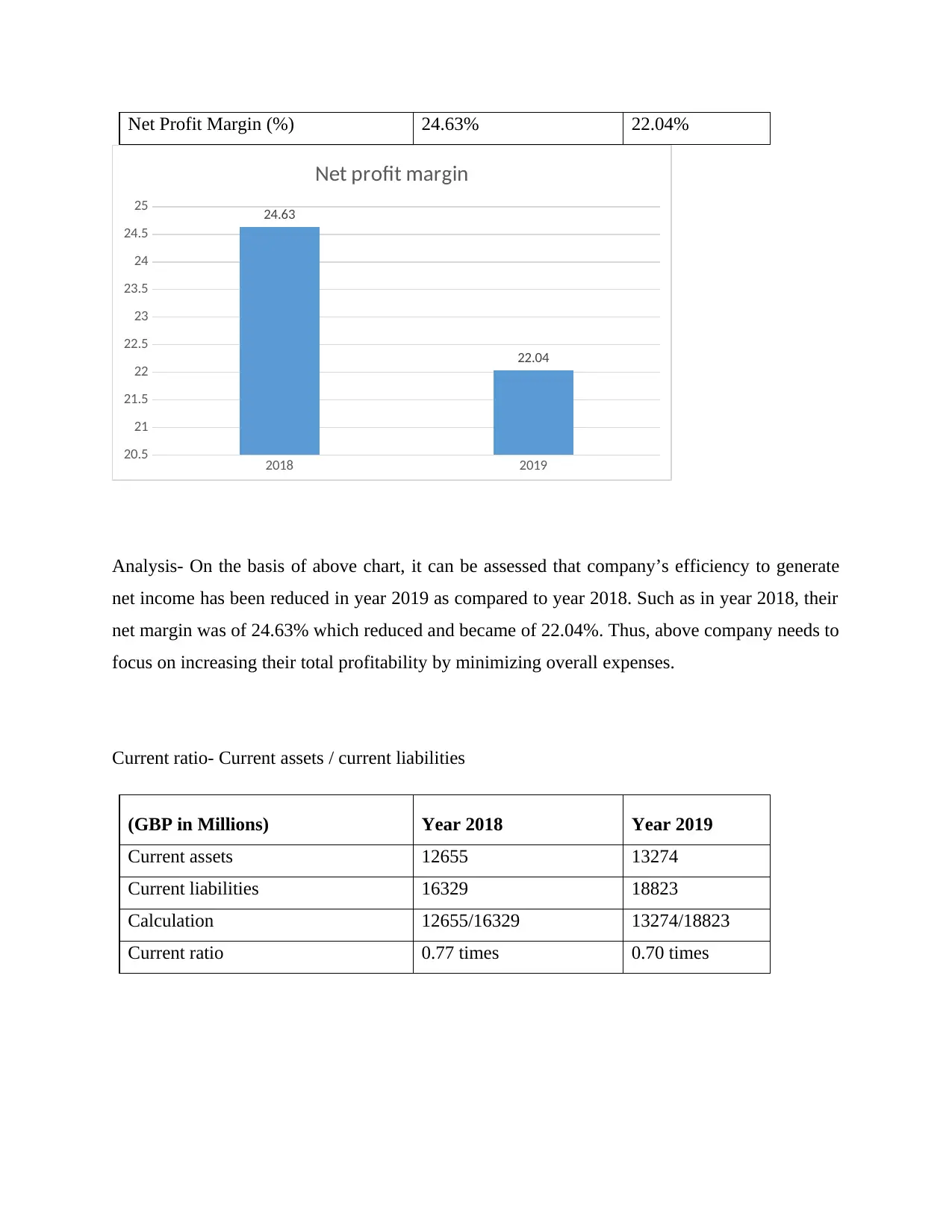
Net Profit Margin (%) 24.63% 22.04%
2018 2019
20.5
21
21.5
22
22.5
23
23.5
24
24.5
25 24.63
22.04
Net profit margin
Analysis- On the basis of above chart, it can be assessed that company’s efficiency to generate
net income has been reduced in year 2019 as compared to year 2018. Such as in year 2018, their
net margin was of 24.63% which reduced and became of 22.04%. Thus, above company needs to
focus on increasing their total profitability by minimizing overall expenses.
Current ratio- Current assets / current liabilities
(GBP in Millions) Year 2018 Year 2019
Current assets 12655 13274
Current liabilities 16329 18823
Calculation 12655/16329 13274/18823
Current ratio 0.77 times 0.70 times
2018 2019
20.5
21
21.5
22
22.5
23
23.5
24
24.5
25 24.63
22.04
Net profit margin
Analysis- On the basis of above chart, it can be assessed that company’s efficiency to generate
net income has been reduced in year 2019 as compared to year 2018. Such as in year 2018, their
net margin was of 24.63% which reduced and became of 22.04%. Thus, above company needs to
focus on increasing their total profitability by minimizing overall expenses.
Current ratio- Current assets / current liabilities
(GBP in Millions) Year 2018 Year 2019
Current assets 12655 13274
Current liabilities 16329 18823
Calculation 12655/16329 13274/18823
Current ratio 0.77 times 0.70 times
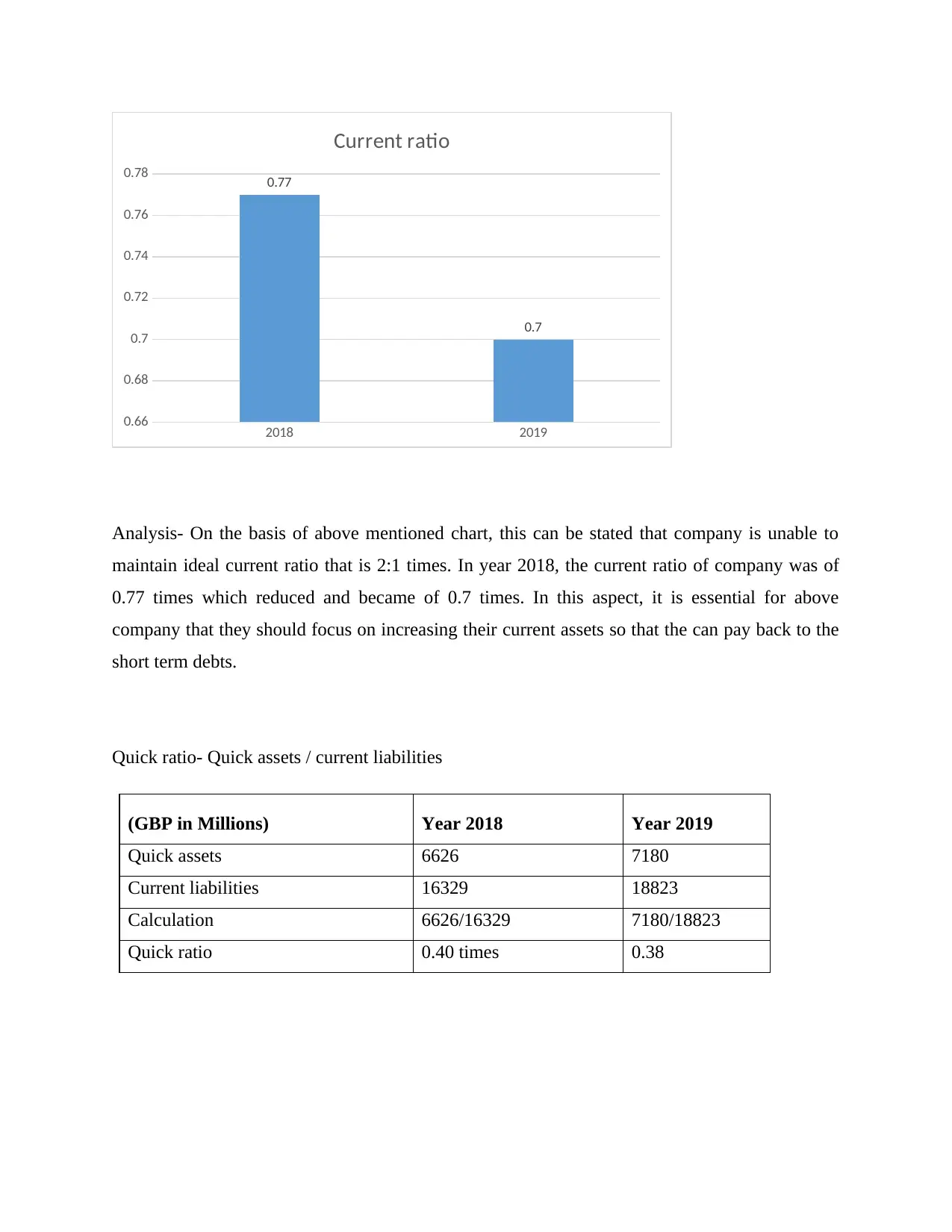
2018 2019
0.66
0.68
0.7
0.72
0.74
0.76
0.78 0.77
0.7
Current ratio
Analysis- On the basis of above mentioned chart, this can be stated that company is unable to
maintain ideal current ratio that is 2:1 times. In year 2018, the current ratio of company was of
0.77 times which reduced and became of 0.7 times. In this aspect, it is essential for above
company that they should focus on increasing their current assets so that the can pay back to the
short term debts.
Quick ratio- Quick assets / current liabilities
(GBP in Millions) Year 2018 Year 2019
Quick assets 6626 7180
Current liabilities 16329 18823
Calculation 6626/16329 7180/18823
Quick ratio 0.40 times 0.38
0.66
0.68
0.7
0.72
0.74
0.76
0.78 0.77
0.7
Current ratio
Analysis- On the basis of above mentioned chart, this can be stated that company is unable to
maintain ideal current ratio that is 2:1 times. In year 2018, the current ratio of company was of
0.77 times which reduced and became of 0.7 times. In this aspect, it is essential for above
company that they should focus on increasing their current assets so that the can pay back to the
short term debts.
Quick ratio- Quick assets / current liabilities
(GBP in Millions) Year 2018 Year 2019
Quick assets 6626 7180
Current liabilities 16329 18823
Calculation 6626/16329 7180/18823
Quick ratio 0.40 times 0.38
⊘ This is a preview!⊘
Do you want full access?
Subscribe today to unlock all pages.

Trusted by 1+ million students worldwide
1 out of 24
Related Documents
Your All-in-One AI-Powered Toolkit for Academic Success.
+13062052269
info@desklib.com
Available 24*7 on WhatsApp / Email
![[object Object]](/_next/static/media/star-bottom.7253800d.svg)
Unlock your academic potential
Copyright © 2020–2025 A2Z Services. All Rights Reserved. Developed and managed by ZUCOL.





